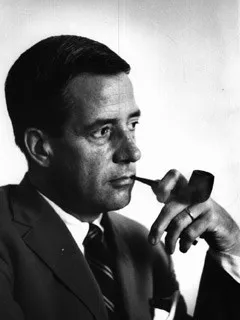1953 Ninth President Courtney Smith

An Iowa-born Rhodes Scholar, Courtney C. Smith (1917-1969) taught English at Princeton and was serving as head of the American Rhodes Scholarship Committee (directly succeeding former Swarthmore's president Frank Aydelotte in the position) when he was selected as the College's ninth president.
Like his predecessor John Nason, Smith also supported the intellectual freedom of the faculty from the start, as expressed in his inaugural address:
"We must see that the headlines do not impugn the loyalty of millions of teachers....Let's not assume because government bodies have a clear legal right to investigate 'Communism' in the colleges that they are wise to exercise that right....Let's limit the investigations to areas where there is a reasonable presumption, as defined by American law, that a law of the land is being violated. Let's ask ourselves where investigations are to end....
"But the student can inquire freely only of freely inquiring teachers. As Quakers affirm the validity of the experimental approach to the truth and the right, so the teacher and scholar would say that his approach is experimental.
"We must resist, then, every effort to suppress free thought or free speech, just as the Society of Friends, known first as the 'Friends of Truth,' have from their very beginnings 300 years ago resisted every form of suppression and insisted on the importance of questioning the accepted and of trying out new ways of doing things."
Under Smith's presidency, Swarthmore solidified its reputation as one of the finest small liberal arts colleges in the country. He set in motion a thorough re-evaluation of the College and increased the financial stability of the school. He appealed to the Ford Foundation and alumni to raise faculty salaries and initiated a Faculty Research Fund, which provided support for professors to pursue independent research. He also reduced the number of honors seminars and better incorporated the library into the College's academic program. Furthermore, Smith oversaw extensive change in the physical campus with the additions of McCabe Library, Sharples Dining Hall, DuPont Science Building, and Worth Health Center.
In June 1968, Smith announced he would resign by fall of the next year. At the time, the campus was tense with the social concerns and anti-war sentiments that typified the 1960s. One major issue concerned negotiations with the Swarthmore African-American Student Society (SASS) to increase the presence of black students on campus.
In January 1969, members of SASS occupied the Admissions Office and demanded that the College take a more active role in the admission and recruitment of African-American students, establish a black studies curriculum, and Black Cultural Center, and increase the number of black faculty and administrators. On Jan. 16, President Smith died of a heart attack in his office, putting the College in a state of shock and prompting SASS to end their sit-in, but not their activism. Smith is the only Swarthmore president to die in office.



